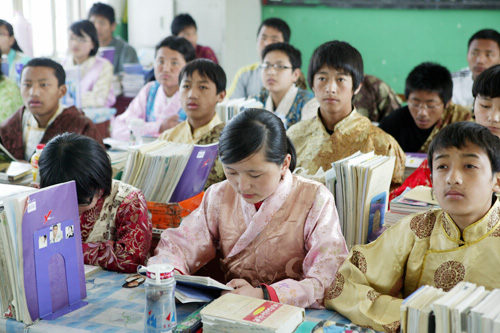|
 |
|
SCHOOLING OUT OF HOMETOWN: Tibetan students attend class in Jinan Tibetan Middle School in eastern Shandong Province. Many such schools outside Tibetan-inhabited regions recruit Tibetan students (CFP) |
Since ancient times, China's inland people have been moving westward to Tibetan-inhabited areas such as the Qinghai-Tibet Plateau, and Tibetan people have been moving eastward from the Qinghai-Tibet Plateau to inland plains and basins.
After the founding of the People's Republic of China in 1949, a large number of inland people moved into Tibetan-inhabited areas in response to the government's calls to aid the construction of the country's border regions, while at the same time, Tibetan people also entered central and eastern areas to study and work.
Since the reform and opening-up policy was implemented in the late 1970s, this two-way population flow has sharply increased in scale, and migrants have become more demographically diverse.
Inlanders have not only migrated to Tibet Autonomous Region, but also to Tibetan-inhabited areas in Sichuan, Qinghai, Gansu and Yunnan provinces, whereas Tibetan people have primarily chosen inland urban destinations.
Since the 1980s, migrants into Tibet and the four other provinces with Tibetan-inhabited areas are predominantly migrant workers and private business owners, who mainly engage in service, construction, and agricultural industries related to Tibetan people's basic needs for clothing, food and lodging. Such entrepreneurs have made special contributions to the region's economic development, social progress, and improved living standards.
Migrants out of Tibetan-inhabited regions have mainly settled in inland cities such as Chengdu, capital of Sichuan Province, and Beijing.
Chengdu, because of its proximity to Tibet and Tibetan-inhabited areas in Sichuan including Garze and Aba, is an ideal place to live for many Tibetans. More than 10,000 people inhabit the city's Tibetan district.
Beijing, the country's capital city and political, cultural and information center, has strong appeal to people from various ethnic groups, including Tibetans. Most Tibetans in Beijing reside in Chaoyang and Haidian districts, in small clusters.
In addition, quite a number of Tibetan migrants also have settled in north China including Inner Mongolia Autonomous Region and areas around the Wutai Mountain in Shanxi Province, northeastern provinces including Liaoning, Jilin and Heilongjiang, and the southern coastal province of Guangdong.
Tibetan migrants mainly engage in trade, service and cultural industries or religious occupations. In these fields, they can take advantage of their linguistic and cultural strengths and find jobs relatively easily; they also have more opportunities to associate with people from the same ethnic group, so that they can adapt to the inland living and social environment more quickly.
The influx of Tibetan migration eastward shows that Tibetans have very strong adaptability and can live harmoniously with Han people and people from other ethnic groups.
Migrant Tibetans either live in small Tibetan communities or blend with people from other ethnic groups. Regardless, they usually communicate with each other in Tibetan. Moreover, they can hold religious activities freely and can disseminate and further develop their religious tradition.
| 